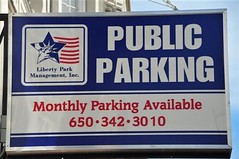Timing the Market, A Banker’s Viewpoint
September 1, 2008
Credit for this post really goes to 3 Oceans contributor Eric Trailer who sent me this content in a letter this week. My clients got it last week, and the blogoshpere can now benefit. We can assume that Eric has better things to do on Labor Day than blog. I’m guessing something involving his lovely wife and son . . .
To see current market data and price trends over the past year for local communities and confirm or refute Eric’s prognostications on the local market in Palo Alto and the surrounding communities,
CLICK HERE to see real-time market data, courtesy of our friends at Altos Research.
As you have likely been hearing, there continues to be more and more evidence that it will cost prospective home buyers more to purchase a home in select areas of the Bay Area as they allow time to go by.
Why? Let’s look at the basic reasons, then review an example:
1. The median price across the board in Palo Alto and the surrounding communities has risen since the beginning of the year.
2. On a national basis, the trough of the market was reached in April.
3. The conforming loan limit will DECREASE over $100,000 in 2009 to $625,000.
4. Rates have risen about .5% since the beginning of the year, despite the increase in the conforming loan limit to $729,750
5. Loan qualifications are becoming more restrictive with each passing week.
6. More restrictions on loans and a tighter supply of money forces rates to go up
7. Because loans require more work to process them (requirements today are 4x what they were a year ago), rates will go up.
8. Inflation is the number one concern of the Fed, and should be the number one concern for all of us.
Let’s say for a moment that you agree that rates are on the rise, but feel as though prices may come down on a $1mm property today; thus, you want to wait. Let’s further assume that you are right and the future price is $950,000, but rates have increased .5% at that future time. Using 20% down, waiting just cost you an ADDITIONAL $117 per month-over $1,400 per year.
But now let’s be more realistic given the appreciation rates of desirable areas of the Bay Area. If rates increase and the $1mm home appreciates to $1,050,000, you are looking at an ADDITIONAL $550 PER MONTH-OVER $6,000 PER YEAR!
What’s the take-away here? Price matters much less than true cost… My motto has always been that it always pays off to buy sooner than later, provided your holding period is greater than four years. And to prove that I walk the walk, I am happy to share my personal situation written as an article titled, “How to Afford a Home in Palo Alto Without a Trust Fund.”
Kindest regards,
Eric
To call Eric on his walking the walk comment, and get a copy of his article, “How to Afford a Home in Palo Alto Without a Trust Fund.”, click on his pretty picture over there in the contributor column to send him an email.
Tags: 4---mortgage-mania, absolute mortgage bank, mortgage rates, Mortgages, palo alto home prices, Palo alto housing market, palo alto market, palo alto real estate market
Sorry, If You Build It, They Are Not Coming
May 12, 2008

(photo credit: mop squad)
Kevin Costner was hot 20 years ago in Field of Dreams. So was that comment “If you build it, they will come.” I received a fantastic comment from a home buyer today for my previous post How Listing Agents Unintentionally Sabotage Their Own Staged Listings:
-
Danica Says:
May 12th, 2008 at 10:51 am That is so true. As a potential buyer, I have been frustrated many times by Craigslist ads that have no picture. There are a ton of houses out there, and I’m trying to weed out the ones I don’t want to look at - it’s really impossible without a picture.I’ve seen so many places, staged or unstaged, that sounded great on paper and then turned out to be hideous-to-unlivable in person.More importantly, even though online listings at a place like Craigslist are free and offer almost unlimited space, a lot of sellers just put up one or two sentences and no pictures - and to me that says “I don’t have it together enough to actually market this house.”And my experience has been that often, that means they don’t know how to deal with the paperwork, or with my questions, or even with basic social skills.I guess in a way it’s helpful to see a boring, picture-less, one-line house ad - because it tells me I don’t want to deal with that seller. But it’s still hilariously frustrating to see an ad online that says something like, “2 BR 1.5 BA NICE!!! MUST SEE CALL JAMES SMITH REALTOR 555-1414!”
This is a brilliant comment, it just goes to show that with that in this fast changing real estate market, our buyers’ behaviors have changed. The old attitude of “If you list it, they will come” no longer works. That worked in the movie Field of Dreams for Kevin Costner but guess what? Kevin Costner is OLD news now. That phrase was coined 20 years ago, so is that attitude. It’s freaking 20 years old. Shouldn’t we move on with the times?
A savvy marketer knows that today’s consumers are so de-sensitized by advertisements that they need more interactive and user-friendly contents [Note: "content," NOT "ads."] to make an educated decision before buying. You can see that through the fast rising numbers of business blogs and web 2.0 services. People want interaction, not sales agenda ramming down their throats.
Also, today’s agents no longer holds monopoly to MLS information. Internet has made today’s buyers more savvy, shrewed, efficient and much more likely to start their buying process without agents. Additionally, if the consumers cannot be satisfied by you, it’s very easy for them to go elsewhere. To be able to work in a competitive market, as a listing agent or FSBO (For Sale By Owners), you will need to get on with the time to provide a comprehensive and user-friendly marketing package.
To do so, here are a few tips as pointed out by Danika, our lovely buyer:
*Online presence is KEY. Staging the property will instantly make the home show-ready online. Once you have staged, having big & high quality photos is a must.
*Don’t just do 1 photo, if you are allowed to post 10, why not do 10?
*Place ONLY good quality photos that will entice buyers’ appetite. Photos like featuring the local eateries or parking lots are not really adding anything to your listing.
*Be creative, not boring and cookie cutter in your listing descriptions. “2Br for sale” is kind of a duh since anyone can read it from the sheet. Why not say something more descriptive that showcase the unique selling points of your listing?
*MOST IMPORTANT: Provide reasonable expectations for buyers. If your listing sounds like the “IT” property to buy and buyers walked into an ill-maintained home, they will turn around and leave immediately because you have wasted their time. If the house is staged, keep it staged while you sell. If you property was already on market then staged, showcase the staged photos online and on flyers and take out the old unstaged photos.
Happy selling!
Cheers,
Cindy
Tags: Buyers, Home selling, photos, Real estate, Staging
What Eliot Spitzer Can Teach You About Listing Photos
March 17, 2008
Unlike Hollywood, sex scandal is not a career launcher for politicians like Eliot Spitzer, now former New York Governor and someone who had single-handedly tanked his own career.
First of all, he is no Paris Hilton. People don’t want to link him with a sex scandal. Second of all, there is a drastic difference between his political image & persona comparing to his exposed image, unlike Paris Hilton who has at least been very consistent in her image as a party girl. So it was not a huge shock that Paris made a sex tape somewhere.

Eliot Spitzer, right, apologised to his family for “private failings” [AFP]
What does Spitzer have to do with Real Estate & Listing Photos?
Like someone in the limelight, your listing needs to present a consistent image front and back, inside and out. In a competitive market, your buyers are critical and they will be picking your listing apart. Also with the ease of internet shopping, it is very easy to overlook your listing while someone else’s looks much nicer and easier on the eye.
I see many MLS photos that present an inconsistent story that does not tell the story of the house.
Let’s look at some real MLS photos I recently pulled off the web:
 It’s too dark to see anything. How big is the room, what is the purpose of this room, can you see? The room also has the “Titanic Effect” where everything is tilted to one side.
It’s too dark to see anything. How big is the room, what is the purpose of this room, can you see? The room also has the “Titanic Effect” where everything is tilted to one side.
 What’s the selling point of this kitchen? More importantly, where is the counter? Does this image say “I am a good seller who takes care of my house?”
What’s the selling point of this kitchen? More importantly, where is the counter? Does this image say “I am a good seller who takes care of my house?”
 Ah I get it, your listing has a floor.
Ah I get it, your listing has a floor.
 What an interesting splash pattern on the floor, was there a dead body?
What an interesting splash pattern on the floor, was there a dead body?
 Am I looking at your floral arrangements or at your house?
Am I looking at your floral arrangements or at your house?
 Are you trying to sell me this house or this giant cabinet? I see I can fit, oh just about 1/3 of the bed into the room.
Are you trying to sell me this house or this giant cabinet? I see I can fit, oh just about 1/3 of the bed into the room.
 Are you advertising for your listings or its neighborhood vendors? Shockingly I see this very often in MLS photos where people show signs of local shops, etc. where there are less than 10 pictures of the home itself. In real estate photos, quantity does NOT equal to quality. As buyers, we want to see quality photos that represent the home well.
Are you advertising for your listings or its neighborhood vendors? Shockingly I see this very often in MLS photos where people show signs of local shops, etc. where there are less than 10 pictures of the home itself. In real estate photos, quantity does NOT equal to quality. As buyers, we want to see quality photos that represent the home well.
 Are we selling the seller’s interesting collections or the house?
Are we selling the seller’s interesting collections or the house?
Now you see why photos are important? The MLS photos is a tool for you to tell the story of the house that you are selling. Leverage it well will bring you success in driving traffic to the open house and showing. We all know a photo is worth a 1,000 words, so let your pictures do the talking.
As the listing agent, you have a tremendous power and control over how you can present and market your listing in the best light. After all, presenting a listing is like presenting your single friend to the dating market — your single friend is gotta look good out there! So let’s make a pack together: us stagers will provide the nice staged home effects ready for show and you the agents will present wonderful and well-shot photographs on the MLS!
Happy selling,
Cindy
Tags: listing, MLS, photos, Real estate, Staging
Bob and Betty Buy a Home (Part 2): We See Some Homes, But Bob and Betty Get Spooked
March 29, 2007
Let’s continue the saga of Bob and Betty, our hypothetical first-time home buyers who were introduced in the first of a series of articles I’ll be writing.
We met at 9am sharp on Saturday morning at my broker’s office in downtown Palo Alto. Though it’s easier to view homes with clients during open house times, I prefer to do first time tours when nobody else is around.
I had an ambitious tour planned: 12 homes in 4 towns along the 101 corridor. Always exhausting for everybody involved — every time I do this I have more liking for the part of the Redfin business model where clients do this bit themselves! — but nonetheless an important part of the whole process.
While driving, I pointed out important things about the neighborhoods we were in: The typical types of homes, the price ranges, which school district it belonged to, whether it was unincorporated or not, whether it was in a flood zone, where the nearest parks and public services were. I asked them to comment on what they liked and didn’t like in each neighborhood.
At each home we went through the same process, slowly at the first couple of homes, and then more quickly. “What did you like? What did you not like? What did you think of that kitchen? Do you like skylights? Fireplaces?”
By the 5th home I’m usually able to “get it” about what clients are looking for, and with this new knowledge, I crossed out 3 of the remaining 7 homes we had to see.
Suitably tired, we pulled back up to the office around 1pm to review what we had seen, what they had liked, and what they had not liked. I explained the next bit of the process: getting pre-approved. I’m happy to spend a few hours as a sort of “interview” with prospective buying clients, but before I invest too much more, I need them to put some skin in the game too by getting pre-approved. I generally find that if they’re not ready to dig up their financial records and go talk to a mortgage broker, then most likely they’re not ready quite yet to buy a home.
Betty was quite excited about three of the homes we had seen, but it was clear that Bob was losing interest pretty quickly. “Yeah…but nine hundred thousand dollars?” was his most common refrain.
We pressed in on that. Bob had been doing his homework the last week and pulled out all the discouraging figures he had found. Housing starts are down. Interest rates are up. Affordability is down. Condo developments in Las Vegas and Miami are being cancelled. How in the world could prices stay where they are here?
Prices in the Bay Area are indeed a pretty head-scratching discussion topic as they continue to defy gravity, pessimism, and seemingly the laws of economics year after year. I told them bluntly that neither I nor anybody else could guarantee anything about prices here. It is indeed possible that prices could collapse…by 40%…overnight…immediately after they bought a place. Possible? Yes. Probable? No.
I pulled up my secret weapon, Google Earth, on the flat screen wall monitor in the conference room. I zoomed in on the Peninsula and asked two questions: 1) How much land is technically available to build on? 2) How much land is actually available to build on.

The answer to the first question is: tons! From the Bay going west pretty much to Highway 280, nearly every square inch of land is already filled in. From the 280 west to the ocean, there are only a smattering of towns, like Half Moon Bay, Pescadero, and La Honda. The mountains make it difficult to build in that area, but we could certainly fit several hundred thousand more homes there.
However…it ain’t gonna happen! Most of that land is owned and/or protected by Federal, State, County, or City governments, private trusts, conservatorships, parks, and so forth, and not much building is going on.
If you can’t go West, then you have to use the Manhattan strategy: go up. Again, that ain’t gonna happen. San Francisco and San Jose have modest but growing skylines of high-rise buildings, but in between it’s rare to find any structure taller than 8 or 10 stories, and for the most part it’s only up to 3 stories tall. Those zoning restrictions aren’t going to be changing any time soon.
Essentially, 50% of the classic economic supply/demand equation is pretty much fixed, so the real question is what will happen with demand?
Again, at least for the short and medium term, the answer to that is pretty clear: demand is, and will likely remain, robust. Google and other local tech companies are doing well. Venture capitalists are pulling out their wallets again. Start-up nirvana 2.0 is here. Immigrants from across the country, and indeed the whole world, continue to move here.
So, could prices fall by 40% overnight? Absolutely! But in the only scenario I can come up with in which that happens — a scenario which involves an earthquake, a terrorist attack, and bankruptcies of the top 5 tech employers in the area…all within 3 months of eachother — falling equity may not even make the top 10 list of concerns for many people.
We parted company, and they promised to get back to me within a few days about whether they were ready to proceed. I had my doubts, mostly about Bob.
Sure enough, a few days later I got a phone call from him. “We’ve decided to wait it out,” he said. “We’re just a bit nervous about these prices, and we’re not in a big hurry to buy.”
We agreed to keep in touch every few weeks and see how things developed.
Welcome to real estate in the Bay Area. Prices are high, and you need a certain amount of faith and intestinal fortitude to dive in for the first time.
Tags: Buy vs. rent, Buyer and seller tips, Choosing an agent, For buyers, Google Earth, Home buying, Previewing homes, Real estate, Redfin
Bob and Betty Buy a Home (Part 1): We Meet, Discuss Their Needs, and Crunch some Numbers
March 4, 2007
Let me introduce you to the two newest stars of this blog: Bob and Betty, a fictional family, sort of a composite blend of numerous past clients. In this x-part series, where “x” is currently an unknown number, I’ll walk you through how we got them into a home, despite the heroic efforts of a cantankerous market, an incompetent mortgage broker (soon fired), and a sleazy Realtor or two to thwart our plans. Enjoy the ride…
————
I first met Bob and Betty about a year ago at a social event hosted by mutual friends. They had moved up to the Bay Area from Los Angeles two years previously after finishing their graduate studies at UCLA — Betty an MBA, and Bob a PhD in bio-something-or-other.
We got talking about the real estate market — a common topic these days — and their sticker shock, only now wearing off, about Bay Area real estate prices. LA prices aren’t exactly cheap either, but the Bay Area certainly has it beat. Bob and Betty were doing what most young recently arrived Bay Area transplants do: renting. Though in no particular hurry to own their own place, they had begun to think about it, but were, quite naturally, concerned about what might happen to home prices. Their angst wasn’t helped much by a constant barrage of doom-and-gloom articles in the media.
We traded emails and spreadsheets a few times, then met for coffee a few weeks later. Since they were both interested in the numbers, I walked them through my “buy vs. rent” analysis, which basically shows that in the short run, it’s definitely cheaper to rent than to buy, but in the long run, with even modest growth assumptions, it’s definitely better to buy than to rent. They appreciated the analysis, but were still skeptical.
Fair enough. The primary motivator for buying a personal residence is usually emotional — stability, putting down roots, raising a family — and the analysis at which I excel (pun intended) is usually just the icing on the cake once they’ve made the emotional commitment to home ownership.
We spent some time talking about what their ideal home might be. They love entertaining, and Bob loves cooking, so a nicely done-up kitchen opening up to an entertaining area would be ideal. Not being much in the handyman department, they prefer a home that’s move-in ready, not a fixer. Bob works in South San Francisco for a biotech company, and Betty in Sunnyvale for a tech startup, so anywhere in between the two — preferably along the 101 corridor — would work. Three bedrooms or more, 1.5 baths or more, roughly 1600 square feet. Betty is somewhat noise sensitive, so too near the highway, a busy road, or the train might not be good. They don’t have kids, and probably won’t for a few years, so being in a good school district isn’t that important.
We talked about their budget, and ran some quick numbers. It seemed that a $950,000 home would be well within their reach.
We made arrangements to meet again the next weekend, when I would show them a half-dozen or so homes that might work, and start to get them acquainted with the neighborhoods.
An excellent first meeting, I thought, though I sensed a certain amount of hesitation in them. I made a note to explore that hesitation further the next time we met.
Tags: Buy vs. rent, Home buying, Real estate
To Preapprove or not to preapprove…that is the question
February 8, 2007
Well, nowadays, and at least in the Bay Area, that is no longer the question. Bay Area buyers have become accustomed to hearing agents, and their friends, emphasize the importance of being “preapproved”. But like many overused and underexplained topic, few people actually fully understand the power of a properly executed preapproval, and how to distinguish it from its more commonplace cousin, a prequalification.
If you are in the market for to buy a home, especially in some of the more competitive neighborhoods of the Bay Area (such as Palo Alto, Menlo Park, Los Altos, Mountain View and San Carlos), your agent – if he or she is any good – will ask you to meet with a qualified mortgage advisor as soon as possible to get prequalified or preapproved. This will serve two main purposes: 1) the agent will be able to serve you best by understanding the range of your affordability and not waste anyone’s time, and 2) you will be able to focus your search on what you know you can comfortably afford and not fall in love with something that was not meant to be. The purpose of the initial meeting with the mortgage specialist is to get “prequalified”; however, you can also get preapproved at the same time. So what’s the difference, and who cares?
Prequalified means that the mortgage specialist has taken a detailed discovery interview of your financial and credit background, along with your housing goals. Based on the information collected, s/he should be able to make a professional decision (based on his/her years of experience and the guidelines published by the lenders) whether or not you are “qualified” to get a loan and approximately how much you can qualify for. Let me stress that this is a decision that the mortgage specialist will make, NOT the person/organization who will ultimately lend you the money. Needless to say, the prequalification has the following weaknesses:

- There is no assurance whether you will actually get a loan or not
Preapproval, when done properly, is much more powerful. It is a prequalification taken to the next step. Preapprovals can take 2 forms:
CONFORMING LOANS ($417K and under)
For conforming loan amounts, the mortgage specialist can actually upload your file information into one of two national approval engines (Fannie Mae or Freddie Mac sponsored), and within minutes, obtain a printed formal approval of your loan amount and any pertaining conditions. This approval, because it is governed by a set of approval criteria that is universally accepted by all lenders, can then be submitted along with the hardcopy of your loan file to your lender of choice. That lender’s underwriting department will in turn accept and adopt the findings generated by this online engine. Hence, once you received an  from this online engine, you can be fully confident that your loan is essentially approved. The reason that mortgage specialist don’t automatically do this is because (sadly) most people in the industry are not properly trained financial advisors and simply don’t know how to use this application, or are not even aware of it! Those who are aware are often deterred by the extra work and/or upfront cost, and so simply downgrade their clients’ to a “prequalification,” assuming that they won’t know the difference anyways.
from this online engine, you can be fully confident that your loan is essentially approved. The reason that mortgage specialist don’t automatically do this is because (sadly) most people in the industry are not properly trained financial advisors and simply don’t know how to use this application, or are not even aware of it! Those who are aware are often deterred by the extra work and/or upfront cost, and so simply downgrade their clients’ to a “prequalification,” assuming that they won’t know the difference anyways.
NON-CONFIRMING (AKA JUMBO) LOANS (Over $417K)
For Jumbo (non-confirming) loans, preapprovals are a bit more complicated, and controversial. Since the national (Fannie Mae or Freddie Mac) engines that are uniformly accepted by all the lenders approve up to $417K – the conforming loan amount limit – many loan agents simply treat jumbo loan preapprovals like prequalifications. That is to say, they use their judgement to see whether a loan would be approved. In most cases, and especially if the agent is seasoned and dependable, the preapproval will not be at risk. But, if time permits and the agent has access to underwriters, it is always safer to discuss the actual loan package with a specific underwriter and obtain a verbal approval. In this case, the loan is not only in good shape according to the agent, but actually considered “approved” according to the person who would ultimately be granting the funds. This “preapproval” is very important – basically, as long as the borrowers can subsequently provide the required documentation (according to loan type) to support what was disclosed to the underwriter, than the written approval would be provided almost immediately upon submission.
Preapprovals, when executed properly, provide buyers with peace of mind when they need to go in with an aggressive offer, such as bypassing finance contingencies. If a loan is preapproved, either through the automated engine or verbally with an underwriter, buyers can be assured that their financing is confirmed within the payment terms of their comfort level, subject to slight market movements prior to locking a loan. However, if a preapproval was not done properly, and the buyers waived finance contingencies, they could be in a sticky situation. I have inherited many clients who have learned this lesson the hard way, having had to back out of a beloved house they won through multiple offers due to a prequalification error, and risking their deposit in the process.
Lastly, while it’s a hard sell, what people don’t realize is that a strong preapproval from a reputable mortgage specialist should placed the buyers in a more desirable position than even a 100% cash buyer. The sellers have no control over what a cash buyer will do with their money between offer acceptance and close of escrow. While not probable, it is possible that the purchase money could go down the drain through a big Vegas visit, or disappear through a bad stock day. Conversely, if the bulk of purchase money is coming from a reputable lender, and the lender has already preapproved, then sellers can have the comfort of knowing that the money is not going anywhere and not accessible to the buyers for any purpose except to buy the house. As a seller, I would much rather to see a strong preapproval than an all cash buyer.
SUMMARY:
- Make sure you know whether you are getting a prequalification or a preapproval (hint, latter is better!) If the person you’re speaking to can’t explain the difference to you – SWITCH!
- If you are getting a preapproval, ask which lenders you have been preapproved with (and why those were chosen)
- Before you waive finance contingencies, make sure that the person doing your preapproval has verified your credit, your cash reserves, and your household income
Tags: Financing-Process, For buyers, Good realtors, Home buying, Loan Application, Menlo Park, Mortgages, Mountain View, Multiple offers, Palo Alto, Preapproval, Prequalification, Real estate, Willows
Rain or Shine — What’s your preference? Depends if You’re a Buyer or Seller…
January 26, 2007
After a long spell of unseasonal sunshine, it looks like the rain may be back. The forecast for this weekend gives us nearly 50/50 odds of being rained out.
Here’s the question — if you’re active in the market right now, which would you prefer: rain or shine? I’d say it depends if you’re a buyer or seller.
If you’re a seller, you definitely want good weather. Bright sunshine and balmy weather triggers the release of home buying pheromones and gets you lots of weekend open house traffic. The more interest in your home, the better.
If you’re a buyer, especially a really committed one, you definitely want bad weather. Cloudy, overcast days, and preferably rain definitely dampens home buyer enthusiasm and reduces competition for that home you’re after.
This may explain the unusually early spring buying season we’ve been experiencing. We often get Seattle-type weather this time of year, with week after endless week of drizzing rain. As soon as the rain stops, the spring buying season starts. Last year the rain stopped late, and so the buyers came out late too. This year the rain stopped early — or so we thought — and the last two weeks have seen pretty frantic activity.
If my theory is right, and this rain persists, the market may taper off and wait until the rain really ends for the season.
Tags: For buyers, For sellers, Home buying, Home selling, Real estate, Strategy, Weather





 Subscribe
Subscribe


